
Illustrative Math Alignment: Grade 6 Unit 9
Putting it All Together
Lesson 1: Fermi Problems
Use the following Media4Math resources with this Illustrative Math lesson.
| Thumbnail Image | Title | Body | Curriculum Topics |
|---|---|---|---|
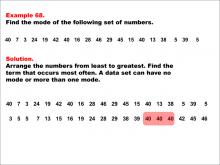
|
Math Example--Measures of Central Tendency--Mode: Example 68 | Math Example--Measures of Central Tendency--Mode: Example 68TopicMeasures of Central Tendency DescriptionThis example showcases a situation of measures of central tendency, where the goal is to identify a key summary measure in a set of data. Example 68 illustrates a set of numbers with the mode highlighted. The numbers are arranged in ascending order. This demonstrates how to identify the mode when a number appears more frequently than others in a data set. |
Data Analysis |
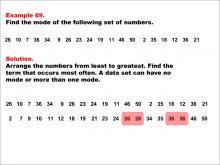
|
Math Example--Measures of Central Tendency--Mode: Example 69 | Math Example--Measures of Central Tendency--Mode: Example 69TopicMeasures of Central Tendency DescriptionThis example showcases a situation where there are multiple modes in a dataset. The image shows how numbers are arranged from least to greatest and highlights two modes: "26" and "36." This demonstrates that datasets can have more than one mode when two or more numbers appear with equal highest frequency. Lessons on measures of central tendency help students understand how to interpret data using different statistical measures like mean and median along with mode. |
Data Analysis |
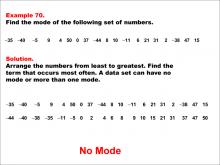
|
Math Example--Measures of Central Tendency--Mode: Example 70 | Math Example--Measures of Central Tendency--Mode: Example 70TopicMeasures of Central Tendency |
Data Analysis |

|
Math Example--Measures of Central Tendency--Mode: Example 71 | Math Example--Measures of Central Tendency--Mode: Example 71TopicMeasures of Central Tendency DescriptionThe image presents a math example on determining the mode of a sequence of numbers. After sorting them in order from least to greatest, the number -7 is highlighted as it appears most frequently. This demonstrates how to identify the mode when a number appears more frequently than others in a data set that includes both positive and negative numbers. Lessons on measures of central tendency help students understand how to interpret data using different statistical measures like mean and median along with mode. |
Data Analysis |
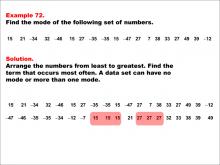
|
Math Example--Measures of Central Tendency--Mode: Example 72 | Math Example--Measures of Central Tendency--Mode: Example 72TopicMeasures of Central Tendency DescriptionThis image shows a math example on finding the mode in a data set. The numbers are sorted from least to greatest with two modes highlighted: 15 and 27. This demonstrates that a data set can have multiple modes, which occurs when two or more numbers appear with the highest frequency. Lessons on measures of central tendency help students understand how to interpret data using different statistical measures like mean and median along with mode. |
Data Analysis |
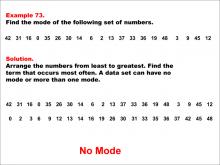
|
Math Example--Measures of Central Tendency--Mode: Example 73 | Math Example--Measures of Central Tendency--Mode: Example 73TopicMeasures of Central Tendency DescriptionThe image shows a math problem about finding the mode of a set of numbers. It includes the original set of numbers and the same set arranged in ascending order. The solution indicates "No Mode". This example reinforces the concept that not all data sets have a mode, particularly when each number in the set appears only once. Lessons on measures of central tendency help students understand how to interpret data using different statistical measures like mean and median along with mode. |
Data Analysis |
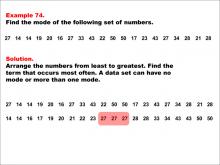
|
Math Example--Measures of Central Tendency--Mode: Example 74 | Math Example--Measures of Central Tendency--Mode: Example 74TopicMeasures of Central Tendency DescriptionThe image presents a math problem about finding the mode of a set of numbers. It shows the original set and the same set arranged in ascending order. The solution highlights the number 27 as occurring most frequently. This demonstrates how to identify the mode when a number appears more frequently than others in a data set. Lessons on measures of central tendency help students understand how to interpret data using different statistical measures like mean and median along with mode. |
Data Analysis |
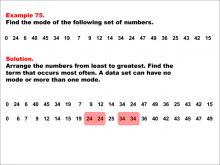
|
Math Example--Measures of Central Tendency--Mode: Example 75 | Math Example--Measures of Central Tendency--Mode: Example 75TopicMeasures of Central Tendency DescriptionThe image displays a math problem about finding the mode of a set of numbers. It includes the original set and the same set arranged in ascending order. The solution highlights two numbers, 24 and 34, as occurring most frequently. This demonstrates that a data set can have multiple modes, which occurs when two or more numbers appear with the highest frequency. Lessons on measures of central tendency help students understand how to interpret data using different statistical measures like mean and median along with mode. |
Data Analysis |

|
Math Example--Measures of Central Tendency--Mode: Example 76 | Math Example--Measures of Central Tendency--Mode: Example 76TopicMeasures of Central Tendency DescriptionThe image shows a math problem about finding the mode of a set of numbers. It presents the original set and the same set arranged in ascending order. The solution indicates "No Mode". This example reinforces the concept that not all data sets have a mode, particularly when each number in the set appears only once. Lessons on measures of central tendency help students understand how to interpret data using different statistical measures like mean and median along with mode. |
Data Analysis |
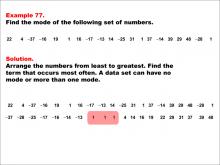
|
Math Example--Measures of Central Tendency--Mode: Example 77 | Math Example--Measures of Central Tendency--Mode: Example 77TopicMeasures of Central Tendency DescriptionThe image shows a math example focused on finding the mode of a set of numbers. The numbers are initially listed in random order and then rearranged from least to greatest. The mode is highlighted. This demonstrates how to identify the mode when a number appears more frequently than others in a data set that includes both positive and negative numbers. Lessons on measures of central tendency help students understand how to interpret data using different statistical measures like mean and median along with mode. |
Data Analysis |
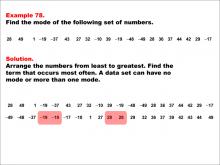
|
Math Example--Measures of Central Tendency--Mode: Example 78 | Math Example--Measures of Central Tendency--Mode: Example 78TopicMeasures of Central Tendency DescriptionThe image depicts another math example on finding the mode. It includes a list of numbers that are sorted from least to greatest. The mode is identified and highlighted in red. This demonstrates how to identify multiple modes when two or more numbers appear with equal highest frequency in a data set. Lessons on measures of central tendency help students understand how to interpret data using different statistical measures like mean and median along with mode. |
Data Analysis |
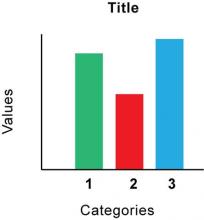
|
Math Clip Art--Statistics--Bar Graph | Math Clip Art--Statistics--Bar Graph
This is part of a collection of math clip art images that show different statistical graphs and concepts, along with some probability concepts. |
Data Analysis |

|
Math Clip Art--Statistics--Box and Whisker Plot | Math Clip Art--Statistics--Box and Whisker Plot
This is part of a collection of math clip art images that show different statistical graphs and concepts, along with some probability concepts. |
Data Analysis |

|
Math Clip Art--Statistics and Probability--Circle Graph | Math Clip Art--Statistics and Probability--Circle Graph
This is part of a collection of math clip art images that show different statistical graphs and concepts, along with some probability concepts. |
Data Analysis |
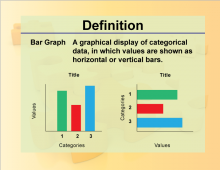
|
Definition--Charts and Graphs--Bar Graph | Definition--Charts and Graphs--Bar Graph
This is a collection of definitions related to the concept of charts, graphs, and data displays. |
Data Analysis |
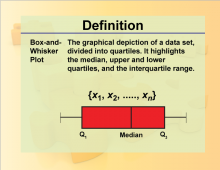
|
Definition--Charts and Graphs--Box-and-Whisker Plot | Definition--Charts and Graphs--Box-and-Whisker Plot
This is a collection of definitions related to the concept of charts, graphs, and data displays. |
Data Analysis |

|
Definition--Charts and Graphs--Circle Graph | Definition--Charts and Graphs--Circle Graph
This is a collection of definitions related to the concept of charts, graphs, and data displays. |
Data Analysis |
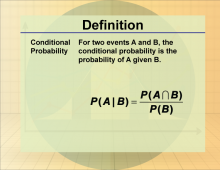
|
Definition--Statistics and Probability Concepts--Conditional Probability | Conditional ProbabilityTopicStatistics and Probability DefinitionConditional probability is the probability of an event occurring given that another event has already occurred. DescriptionConditional probability is used in statistics to refine predictions and is essential in fields like epidemiology and finance. For example, the probability of drawing a red card given that is a face card is drawn is a conditional probability. Understanding conditional probability is crucial for students to analyze dependent events and make informed predictions. |
Data Analysis |
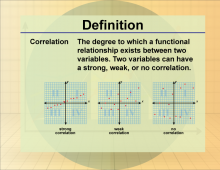
|
Definition--Statistics and Probability Concepts--Correlation 1 | Correlation 1TopicStatistics and Probability DefinitionCorrelation measures the strength and direction of a linear relationship between two variables. DescriptionCorrelation is widely used in statistics to assess the relationship between variables, such as height and weight, and is applicable in fields like economics, psychology, and biology. A positive correlation indicates that as one variable increases, the other also increases. Understanding correlation helps students make predictions and understand data trends. |
Data Analysis |
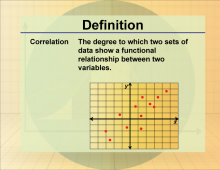
|
Definition--Statistics and Probability Concepts--Correlation 2 | Correlation 2TopicStatistics and Probability DefinitionCorrelation measures the strength and direction of a linear relationship between two variables. DescriptionCorrelation is widely used in statistics to assess the relationship between variables, such as height and weight, and is applicable in fields like economics, psychology, and biology. A positive correlation indicates that as one variable increases, the other also increases. Understanding correlation helps students make predictions and understand data trends. |
Data Analysis |

|
Definition--Statistics and Probability Concepts--Histogram | HistogramTopicStatistics and Probability DefinitionA histogram is a graphical representation of data distribution using bars of different heights. DescriptionHistograms are a fundamental tool in statistics for visualizing the frequency distribution of a dataset. They are used across various fields, including economics, biology, and engineering, to analyze data patterns and trends. By displaying data in intervals, histograms help identify the shape, central tendency, and variability of data. For students, understanding histograms is crucial for interpreting data visually and making informed decisions based on statistical evidence. |
Data Analysis |

|
Definition--Charts and Graphs--Line Graph | Definition--Charts and Graphs--Line Graph
This is a collection of definitions related to the concept of charts, graphs, and data displays. |
Data Analysis |
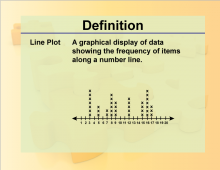
|
Definition--Charts and Graphs--Line Plot | Definition--Charts and Graphs--Line Plot
This is a collection of definitions related to the concept of charts, graphs, and data displays. |
Data Analysis |
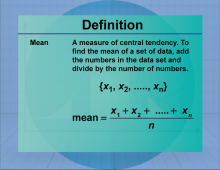
|
Definition--Measures of Central Tendency--Mean | MeanTopicStatistics DefinitionThe mean is a measure of central tendency that provides an average representation of a set of data. DescriptionThe Mean is an important concept in statistics, used to summarize data effectively. In real-world applications, the Mean helps to interpret data distributions and is widely used in areas such as economics, social sciences, and research. For example, if a data set consists of the values 2, 3, and 10, the mean is calculated as (2 + 3 + 10)/3 = 5. |
Data Analysis |
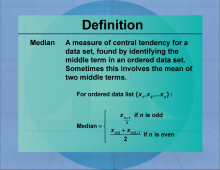
|
Definition--Measures of Central Tendency--Median | MedianTopicStatistics DefinitionThe median is a measure of central tendency that provides the middle value of a data set.. DescriptionThe Median is an important concept in statistics, used to summarize data effectively. In real-world applications, the Median helps to interpret data distributions and is widely used in areas such as economics, social sciences, and research. For large data sets, the Median provdes an average that doesn't involve the massive calculation of a mean. |
Data Analysis |
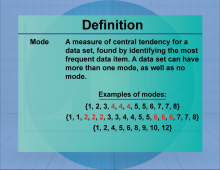
|
Definition--Measures of Central Tendency--Mode | ModeTopicStatistics DefinitionThe mode is the most frequent data item.. DescriptionThe Mode is an important concept in statistics, used to summarize data effectively. It is the most frequent data item in a data set. A data set can have more than one mode. In mathematics education, understanding mode is crucial as it lays the foundation for more advanced statistical concepts. It allows students to grasp the significance of data analysis and interpretation. In classes, students often perform exercises calculating the mean of sets, which enhances their understanding of averaging techniques. |
Data Analysis |
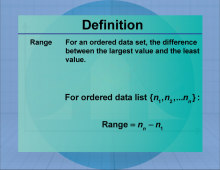
|
Definition--Measures of Central Tendency--Range | RangeTopicStatistics DefinitionThe range is the difference between the highest and lowest values in a data set. DescriptionThe range is a simple measure of variability that indicates the spread of a data set. It is calculated by subtracting the smallest value from the largest value, providing a quick sense of the data's dispersion. The range is used in various fields, including finance and quality control, to assess the variability and consistency of data. |
Data Analysis |
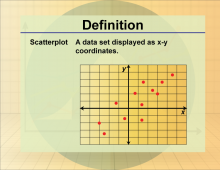
|
Definition--Statistics and Probability Concepts--Scatterplot | ScatterplotTopicStatistics and Probability DefinitionA scatterplot is a graphical representation of the relationship between two numerical variables. DescriptionScatterplots are essential tools in statistics for visualizing the correlation between two variables. They are widely used in fields like economics and biology to identify trends and relationships in data. For students, understanding scatterplots is important for interpreting data visually and analyzing the strength and direction of relationships between variables. This skill is crucial for developing their ability to conduct statistical analyses and draw meaningful conclusions from data. |
Data Analysis |
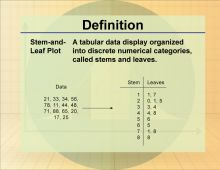
|
Definition--Statistics and Probability Concepts--Stem-and-Leaf Plot | Stem-and-Leaf PlotTopicStatistics and Probability DefinitionA stem-and-leaf plot is a graphical representation that organizes data points based on their place value. DescriptionStem-and-leaf plots are useful for displaying the distribution of a dataset in a concise format, preserving the original data while showing its shape. They are particularly helpful in exploratory data analysis to identify patterns and outliers. In educational settings, stem-and-leaf plots are used to teach students about data organization and visualization. Understanding this concept helps students develop skills in data interpretation and enhances their ability to summarize data effectively. |
Data Analysis |
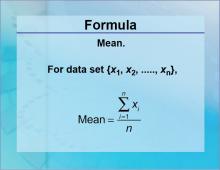
|
Formulas--Mean | Formulas--Mean
The formula for the Mean. This is part of a collection of math formulas. To see the complete collection of formulas, click on this link. Note: The download is a JPG file.Related ResourcesTo see resources related to this topic click on the Related Resources tab above. |
Data Analysis |

|
Formulas--Median | Formulas--Median
The formula for the Median. This is part of a collection of math formulas. To see the complete collection of formulas, click on this link. Note: The download is a JPG file.Related ResourcesTo see resources related to this topic click on the Related Resources tab above. |
Data Analysis |

|
INSTRUCTIONAL RESOURCE: Nspire App Tutorial: Graphing a Scatterplot | In this Slide Show, learn how graph data in a scatterplot using the graph window. This presentation requires the use of the TI-Nspire iPad App. Note: the download is a PPT. |
Graphs of Linear Functions, Slope-Intercept Form and Data Analysis |

|
MATH EXAMPLES--The Mean | MATH EXAMPLES--The Mean
This set of tutorials provides 42 examples of calculating the mean. NOTE: The download is a PPT file. |
Data Analysis |

|
MATH EXAMPLES--The Median | MATH EXAMPLES--The Median
This set of tutorials provides 40 examples of calculating the median. NOTE: The download is a PPT file. |
Data Analysis |

|
MATH EXAMPLES--The Mode | MATH EXAMPLES--The Mode
This set of tutorials provides 78 examples of calculating the mode. NOTE: The download is a PPT file. |
Data Analysis |

|
MATH EXAMPLES--The Range | MATH EXAMPLES--The Range
This set of tutorials provides 26 examples of calculating the range. NOTE: The download is a PPT file. |
Data Analysis |

|
Math in the News: Issue 67--Election Results | Math in the News: Issue 67--Election Results
November 2012. In this issue of Math in the News, we look at statistics for the recent Presidential election. This is part of the Math in the News collection. To see the complete collection, click on this link. Note: The download is a PPT file.Related ResourcesTo see resources related to this topic click on the Related Resources tab above. |
Data Analysis |
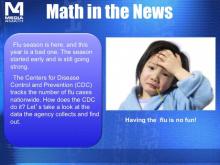
|
Math in the News: Issue 68--Flu Season | Math in the News: Issue 68--Flu Season
February 2013. In this issue of Math in the News, we look at statistics for the flu season. This is part of the Math in the News collection. To see the complete collection, click on this link. Note: The download is a PPT file.Related ResourcesTo see resources related to this topic click on the Related Resources tab above. |
Data Analysis |

|
Math in the News: Issue 69--The Russian Meteorite | Math in the News: Issue 69--The Russian Meteorite
February 2013. In this issue of Math in the News we look at statistics related to Russian meteor that recently crash-landed. Watch some compelling eyewitness video and explore how the path of meteor was reconstructed. This is part of the Math in the News collection. To see the complete collection, click on this link. Note: The download is a PPT file.Related ResourcesTo see resources related to this topic click on the Related Resources tab above. |
Data Analysis |

|
Math in the News: Issue 72--Box Office Flop! | Math in the News: Issue 72--Box Office Flop!
August 2013. In this issue we analyze why the movie the Lone Ranger is considered a box office flop, even though it has earned nearly $100 million. We analyze box office data. This is part of the Math in the News collection. To see the complete collection, click on this link. Note: The download is a PPT file.Related ResourcesTo see resources related to this topic click on the Related Resources tab above. |
Applications of Exponential and Logarithmic Functions, Data Analysis and Sequences |
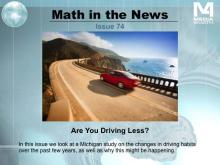
|
Math in the News: Issue 74--Are You Driving Less? | Math in the News: Issue 74--Are You Driving Less?
August 2013. In this issue we look at the University of Michigan Study on American driving habts. The results show that Americans are driving less. But why is this? We look at the data and draw some conclusion. This is part of the Math in the News collection. To see the complete collection, click on this link. Note: The download is a PPT file.Related ResourcesTo see resources related to this topic click on the Related Resources tab above. |
Data Analysis |

|
Math in the News: Issue 75--A Swim for the Ages | Math in the News: Issue 75--A Swim for the Ages
August 2013. In this issue we look at Diana Nyad's remarkable swim from Cuba to Florida. It becomes an opportunity to explore Average Speed. This is part of the Math in the News collection. To see the complete collection, click on this link. Note: The download is a PPT file.Related ResourcesTo see resources related to this topic click on the Related Resources tab above. |
Data Analysis |
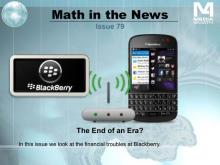
|
Math in the News: Issue 79--The End of an Era? | Math in the News: Issue 79--The End of an Era?
September 2013. In this issue we take a second look at Blackberry's financial woes. This is a follow-up report from Issue 52, where we looked at the company's revenue problems. Here we examine its final fate. This is part of the Math in the News collection. To see the complete collection, click on this link. Note: The download is a PPT file.Related ResourcesTo see resources related to this topic click on the Related Resources tab above. |
Data Analysis |
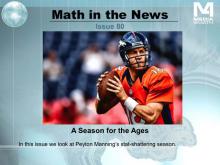
|
Math in the News: Issue 80--A Season for the Ages | Math in the News: Issue 80--A Season for the Ages
October 2013. In this issue we follow Peyton Manning's extraordinary season with the Denver Broncos. This is a follow-up from Issue 51. This is an excellent opportunity to look at different data graphs, including box-and-whisker plots, bar graphs, and tabular data. This is part of the Math in the News collection. To see the complete collection, click on this link. Note: The download is a PPT file.Related ResourcesTo see resources related to this topic click on the Related Resources tab above. |
Data Analysis |
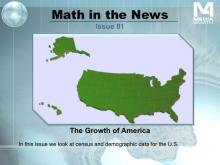
|
Math in the News: Issue 81--The Growth of America | Math in the News: Issue 81--The Growth of America
October 2013. In this issue we look at how America has grown from its formation as a country. We look at the increase in the number of states, the increase in the population, and the demographic factors that have become prominent in recent years. We look at data in tables and graphs. This is part of the Math in the News collection. To see the complete collection, click on this link. Note: The download is a PPT file.Related ResourcesTo see resources related to this topic click on the Related Resources tab above. |
Data Analysis |
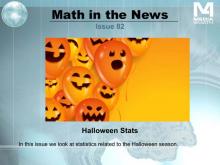
|
Math in the News: Issue 82--Halloween Stats | Math in the News: Issue 82--Halloween Stats
October 2013. In this issue we look at statistics related to Halloween 2013. We explore how the economy is affecting holiday spending. We also investigate why Halloween has grown in popularity over the years. This is part of the Math in the News collection. To see the complete collection, click on this link. Note: The download is a PPT file.Related ResourcesTo see resources related to this topic click on the Related Resources tab above. |
Data Analysis |

|
Math in the News: Issue 83--Super Typhoon Haiyan | Math in the News: Issue 83--Super Typhoon Haiyan
November 2013. In this issue of Math in the News we look at Typhoon Haiyan to learn to distinguish between typhoons and hurricanes. This creates an opportunity to use Venn Diagrams as a means of classifying information. This is part of the Math in the News collection. To see the complete collection, click on this link. Note: The download is a PPT file.Related ResourcesTo see resources related to this topic click on the Related Resources tab above. |
Data Analysis |

|
Math in the News: Issue 85--2013 Movies: A Year in Review | Math in the News: Issue 85--2013 Movies: A Year in Review
January 2014. In this issue of Math in the News we look at box office data from 2013. We look for patterns in the data and analyze the data using different data displays, including bar graphs, line graphs, scatterplot, and tables. This provides an excellent opportunity for data analysis. This is part of the Math in the News collection. To see the complete collection, click on this link. Note: The download is a PPT file.Related ResourcesTo see resources related to this topic click on the Related Resources tab above. |
Data Analysis |
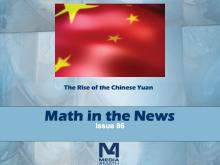
|
Math in the News: Issue 86--The Rise of the Chinese Yuan | Math in the News: Issue 86--The Rise of the Chinese Yuan
January 2014. In this issue of Math in the News we look at the foreign exchange market and the rise of the Chinese Yuan. The Yuan has become a significant player in the foreign exchange market and we look at currency exchange, and how to convert from one currency to another by solving a proportion. This issue provides an excellent opportunity to introduce the mathematics of money on the international market. This is part of the Math in the News collection. To see the complete collection, click on this link. Note: The download is a PPT file.Related ResourcesTo see resources related to this topic click on the Related Resources tab above. |
Data Analysis |
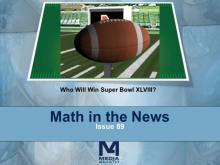
|
Math in the News: Issue 89--Who Will Win Super Bowl XLVIII? | Math in the News: Issue 89--Who Will Win Super Bowl XLVIII?
January 2014. In this issue of Math in the News we look at football statistics to examine who stands the best chance of winning Super Bowl XLVIII. This is an excellent opportunity for data analysis. This is part of the Math in the News collection. To see the complete collection, click on this link. Note: The download is a PPT file.Related ResourcesTo see resources related to this topic click on the Related Resources tab above. |
Data Analysis |